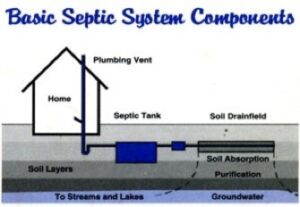How to Care for Your Septic System
 As we learned from our Water Quality Management Study septic systems impact surface water bodies and local drinking water wells. Nutrient loading in our ponds is a serious problem increasing the likelihood of cyanobacteria blooms and is largely a result of activities 250 to 300 feet from the water’s edge. It is estimated that 75% of phosphorus in waste water now comes from toilets following the elimination of phosphorus from detergents. The extent of this impact depends on how well your septic system is maintained and if it is used properly. Septic system maintenance is not complicated, and it does not need to be expensive. Upkeep comes down to four key elements:
As we learned from our Water Quality Management Study septic systems impact surface water bodies and local drinking water wells. Nutrient loading in our ponds is a serious problem increasing the likelihood of cyanobacteria blooms and is largely a result of activities 250 to 300 feet from the water’s edge. It is estimated that 75% of phosphorus in waste water now comes from toilets following the elimination of phosphorus from detergents. The extent of this impact depends on how well your septic system is maintained and if it is used properly. Septic system maintenance is not complicated, and it does not need to be expensive. Upkeep comes down to four key elements:
Inspect and Pump Frequently: Inspect every two to three years by a septic service professional. Household septic tanks are typically pumped every three to five years depending on household size, total wastewater generated and volume of solids in wastewater. If the septic system is not monitored, solids from the septic tank will overflow into the soil drainfield necessitating a preventable, expensive replacement.
Use Water Efficiently: All of the water a household sends down its pipes winds up in its septic system. Just a single leaky or running toilet can waste as much as 200 gallons of water per day. Toilet use accounts for 25 to 30 percent of household water use. Consider installing a high efficiency toilet which use 1.6 gallons of water or less per flush. Faucet aerators, high-efficiency showerheads, and shower flow restrictors help reduce water use.
 Properly Dispose of Waste: Your septic system is not a trashcan. Do not flush anything besides human waste and toilet paper. Never flush: cooking grease or oil, non-flushable wipes, such as baby wipes or other wet wipes, cat litter, paper towels, pharmaceuticals, household chemicals like gasoline, oil, pesticides, antifreeze, and paint or paint thinners. Avoid chemical drain openers for a clogged drain. Instead, use boiling water or a drain snake. Eliminate or limit the use of a garbage disposal. This will significantly reduce the amount of fats, grease, and solids that enter your septic tank and ultimately clog its drainfield.
Properly Dispose of Waste: Your septic system is not a trashcan. Do not flush anything besides human waste and toilet paper. Never flush: cooking grease or oil, non-flushable wipes, such as baby wipes or other wet wipes, cat litter, paper towels, pharmaceuticals, household chemicals like gasoline, oil, pesticides, antifreeze, and paint or paint thinners. Avoid chemical drain openers for a clogged drain. Instead, use boiling water or a drain snake. Eliminate or limit the use of a garbage disposal. This will significantly reduce the amount of fats, grease, and solids that enter your septic tank and ultimately clog its drainfield.
Maintain Your Drainfield: Never park or drive on your drainfield. Keep roof drains, sump pumps, and other rainwater drainage systems away from your drainfield area. Excess water slows down or stops the wastewater treatment process. Plant trees the appropriate distance from your drainfield to keep roots from growing into your septic system.
Your septic system contains a collection of living organisms that digest and treat household waste. Avoid harsh chemicals and cleaners such as bleach, which will destroy the beneficial bacteria in your system.
If the system is abused by the frequent use of a grinder, heavy use of chemical cleaners such as bleach, washing out paint brushes, flushing anything not intended for introduction into the system, flushing unused medicines, then the system may need to be pumped every 1 to 2 years.
This information came from the EPA website for more information go to: https://www.epa.gov/septic/how-care-your-septic-system

Comments
How to Care for Your Septic System — No Comments
HTML tags allowed in your comment: <a href="" title=""> <abbr title=""> <acronym title=""> <b> <blockquote cite=""> <cite> <code> <del datetime=""> <em> <i> <q cite=""> <s> <strike> <strong>